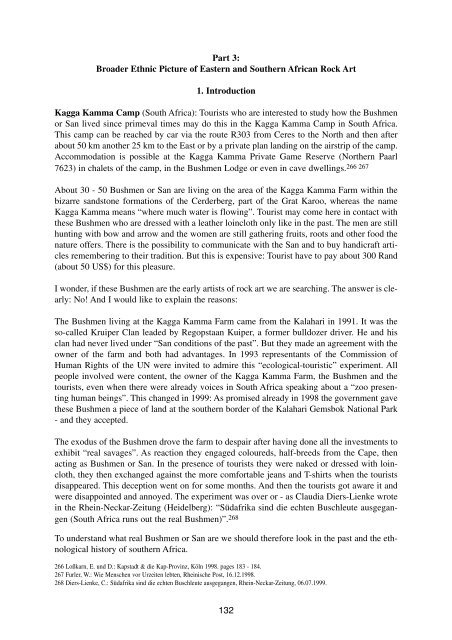1.) schw.weiss - StoneWatch
1.) schw.weiss - StoneWatch
1.) schw.weiss - StoneWatch
Create successful ePaper yourself
Turn your PDF publications into a flip-book with our unique Google optimized e-Paper software.
Part 3:<br />
Broader Ethnic Picture of Eastern and Southern African Rock Art<br />
<strong>1.</strong> Introduction<br />
Kagga Kamma Camp (South Africa): Tourists who are interested to study how the Bushmen<br />
or San lived since primeval times may do this in the Kagga Kamma Camp in South Africa.<br />
This camp can be reached by car via the route R303 from Ceres to the North and then after<br />
about 50 km another 25 km to the East or by a private plan landing on the airstrip of the camp.<br />
Accommodation is possible at the Kagga Kamma Private Game Reserve (Northern Paarl<br />
7623) in chalets of the camp, in the Bushmen Lodge or even in cave dwellings. 266 267<br />
About 30 - 50 Bushmen or San are living on the area of the Kagga Kamma Farm within the<br />
bizarre sandstone formations of the Cerderberg, part of the Grat Karoo, whereas the name<br />
Kagga Kamma means “where much water is flowing”. Tourist may come here in contact with<br />
these Bushmen who are dressed with a leather loincloth only like in the past. The men are still<br />
hunting with bow and arrow and the women are still gathering fruits, roots and other food the<br />
nature offers. There is the possibility to communicate with the San and to buy handicraft articles<br />
remembering to their tradition. But this is expensive: Tourist have to pay about 300 Rand<br />
(about 50 US$) for this pleasure.<br />
I wonder, if these Bushmen are the early artists of rock art we are searching. The answer is clearly:<br />
No! And I would like to explain the reasons:<br />
The Bushmen living at the Kagga Kamma Farm came from the Kalahari in 199<strong>1.</strong> It was the<br />
so-called Kruiper Clan leaded by Regopstaan Kuiper, a former bulldozer driver. He and his<br />
clan had never lived under “San conditions of the past”. But they made an agreement with the<br />
owner of the farm and both had advantages. In 1993 representants of the Commission of<br />
Human Rights of the UN were invited to admire this “ecological-touristic” experiment. All<br />
people involved were content, the owner of the Kagga Kamma Farm, the Bushmen and the<br />
tourists, even when there were already voices in South Africa speaking about a “zoo presenting<br />
human beings”. This changed in 1999: As promised already in 1998 the government gave<br />
these Bushmen a piece of land at the southern border of the Kalahari Gemsbok National Park<br />
- and they accepted.<br />
The exodus of the Bushmen drove the farm to despair after having done all the investments to<br />
exhibit “real savages”. As reaction they engaged coloureds, half-breeds from the Cape, then<br />
acting as Bushmen or San. In the presence of tourists they were naked or dressed with loincloth,<br />
they then exchanged against the more comfortable jeans and T-shirts when the tourists<br />
disappeared. This deception went on for some months. And then the tourists got aware it and<br />
were disappointed and annoyed. The experiment was over or - as Claudia Diers-Lienke wrote<br />
in the Rhein-Neckar-Zeitung (Heidelberg): “Südafrika sind die echten Buschleute ausgegangen<br />
(South Africa runs out the real Bushmen)”. 268<br />
To understand what real Bushmen or San are we should therefore look in the past and the ethnological<br />
history of southern Africa.<br />
266 Loßkarn, E. und D.: Kapstadt & die Kap-Provinz, Köln 1998. pages 183 - 184.<br />
267 Furler, W.: Wie Menschen vor Urzeiten lebten, Rheinische Post, 16.12.1998.<br />
268 Diers-Lienke, C.: Südafrika sind die echten Buschleute ausgegangen, Rhein-Neckar-Zeitung, 06.07.1999.<br />
132
















